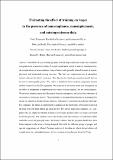| dc.contributor.author | Frumento, Paolo | |
| dc.contributor.author | Mealli, Fabrizia | |
| dc.contributor.author | Pacini, Barbara | |
| dc.contributor.author | Rubin, Donald B. | |
| dc.date.accessioned | 2012-07-18T18:11:28Z | |
| dc.date.issued | 2012-07-18 | |
| dc.identifier.citation | Frumento, Paolo, Fabrizia Mealli, Barbara Pacini, and Donald B. Rubin. 2012. Evaluating the effect of training on wages in the presence of noncompliance, nonemployment, and missing outcome data. Journal of the American Statistical Union 107(498): 450-466. | en_US |
| dc.identifier.issn | 0162-1459 | en_US |
| dc.identifier.uri | http://nrs.harvard.edu/urn-3:HUL.InstRepos:9275635 | |
| dc.description.abstract | The effects of a job-training program on both employment and wages are evaluated, using data from a randomized study. Principal stratification is used to address, simultaneously, the complications of noncompliance, wages that are only partially defined because of nonemployment, and unintended missing outcomes. The first two complications are of substantive interest, whereas the third is a nuisance. The objective is to find a parsimonious model that can be used to inform public policy. We conduct a likelihood-based analysis using finite mixture models estimated by the EM algorithm. We maintain an exclusion restriction assumption for the effect of assignment on employment and wages for noncompliers, but not on missingness. We provide estimates under the Missing at Random assumption, and assess the robustness of our results to deviations from it. The plausibility of meaningful restrictions is investigated by means of scaled log-likelihood ratio statistics. Substantive conclusions include the following. For compliers, the effect on employment is negative in the short term; it becomes positive in the long term, but these effects are small at best. For always employed compliers, i.e., compliers who are employed whether trained or not trained, positive effects on wages are found at all time periods. Our analysis reveals that background characteristics of individuals differ markedly across the principal strata. We found evidence that the program should have been better targeted, in the sense of being designed diffrently for different groups of people, and specific suggestions are offered. Previous analyses of this data set, which did not address all complications in a principled manner, led to less nuanced conclusions about Job Corps. | en_US |
| dc.description.sponsorship | Statistics | en_US |
| dc.language.iso | en_US | en_US |
| dc.publisher | American Statistical Union | en_US |
| dc.relation.isversionof | doi:10.1080/01621459.2011.643719 | en_US |
| dc.relation.hasversion | http://www.cide.info/conf/2009/iceee2009_submission_258.pdf | en_US |
| dash.license | OAP | |
| dc.subject | EM algorithm | en_US |
| dc.subject | finite mixture models | en_US |
| dc.subject | missing at random | en_US |
| dc.subject | noncompliance | en_US |
| dc.subject | partially defined outcomes | en_US |
| dc.subject | principal stratification | en_US |
| dc.subject | Rubin causal model | en_US |
| dc.subject | training | en_US |
| dc.subject | wages | en_US |
| dc.title | Evaluating the Effect of Training on Wages in the Presence of Noncompliance, Nonemployment, and Missing Outcome Data | en_US |
| dc.type | Journal Article | en_US |
| dc.description.version | Accepted Manuscript | en_US |
| dc.relation.journal | Journal of the American Statistical Union | en_US |
| dash.depositing.author | Rubin, Donald B. | |
| dc.date.available | 2012-07-18T18:11:28Z | |
| dc.identifier.doi | 10.1080/01621459.2011.643719 | * |
| dash.contributor.affiliated | Rubin, Donald | |


